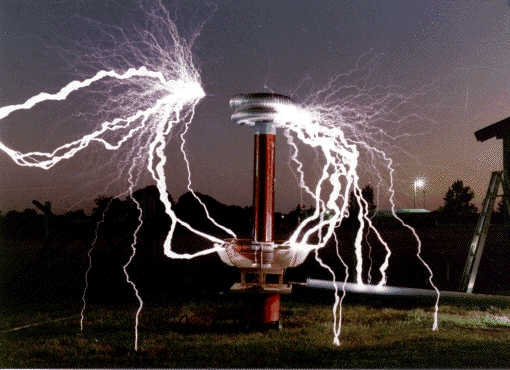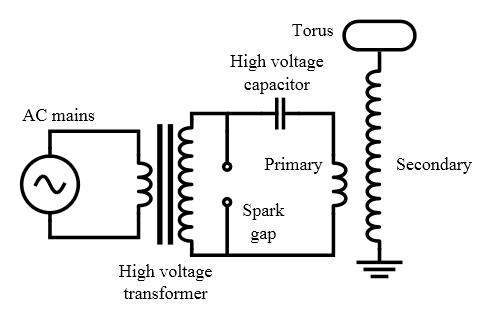Tesla coil
claimed by Julia Denniss (Fall 2016)
Tesla Coil
Named for its inventor, Nikola Tesla, a Tesla coil is an electrical resonant transformer circuit capable of producing a potential of millions of volts. The coil is used to produce high-voltage, low-current, high frequency alternating-current electricity. The Tesla coil was initially created as a power supply for Tesla's "System of Electric Lighting" and was used in experiments in electrical lighting, wireless telegraphy, and X-rays. The Tesla coil first appeared in Tesla's patent No. 454,622 (1891) for use in electric lighting. Tesla coils can output anywhere from 50 kilovolts to several million volts for larger coils. The alternating current output is usually between 50 kHz and 1 MHz, in the low frequency radio range.
Fundamental Principles and Models
Tesla coils can produce massive electrical fields due to their ability to create high voltages. They are comparable to transformers, as they also utilize electromagnetic induction, yet there are key differences between the two. The main principle behind the Tesla coil is achieving resonance.
Resonance occurs when the primary coil transfers the current to the secondary coil at the exact time when the energy passed on will be at a maximum. An adjustable spark gap gives the user more control over the voltage of the current produced. The primary and secondary coils must be tuned to resonate with each other. With a significant amount of voltage, the air in the internal spark plug gap will become ionized, forming a circuit. Through a series of capacitors, the coils can produce the required voltage. The common 2-coil circuit includes a high-voltage transformer (usually between 5-30 kilovolts), a capacitor, a spark gap, and the coils themselves. Optionally, an electrode in the form of a torus with a large surface area can be attached to the second terminal of the coil to suppress corona discharge and arcs. Corona discharges occur when electric field strength surpasses the dielectric strength of the air. This results in a loss of energy that damps oscillation and prevents voltage from reaching a theoretical maximum, as predicted by lossless models. The torus's large diameter and surface area reduces the potential gradient at the high voltage terminal, which increases the threshold at which corona discharges occur and decreases their likeliness.
The condition for resonance between the first and second coils is as follows:
L1C1 = L2C2
where L is the magnetic inductance in henries, and C is the capacitance in farads. 1 and 2 indicate the first and second coils. This equation only applies if the secondary coil is not adjustable, meaning that the first coil must be adjusted to the second.
The equation to find the voltage is as follows:
V2 = V1\sqrt{C1 \ C2} = V1\sqrt{L2 \ L1}
where V is the voltage in volts, C is the capacitance in farads, and L is the inductance in henries. 1 indicates the first coil, and 2 indicates the second coil. This formula is derived from the above formula. Inductance is calculated differently based on the shape of the coil (spiral, helical, or inverse conical).
The resonant frequency of the circuit can be found with the following equation:
F= 1/(2*pi*sqrt{L*C})
where F is the frequency in Hertz, L is the inductance in henries, and C is the capacitance in farads.
History
Around 1891, Tesla created the Tesla coil while expanding on and repeating the experiments of Heinrich Hertz, who had discovered electromagnetic radiation in 1888. He intended to go beyond the traditional iron-core transformer design to generate higher-frequency radio waves. As part of the design, Tesla initially utilized a high-speed alternator but found that the high frequency current melted the insulation and overheated the iron core. He then included a "spark gap" into the system, which put a gap of insulating material between the primary and secondary windings, while also eliminating the iron core entirely. He also placed a capacitor between the alternator and the primary winding to avoid burning out the coil. The capacitor could connect through the short gap to the primary winding set to form a resonant circuit, once it was first charged to a high enough voltage to rupture the air in the gap. The current through the spark gap causes the primary resonant circuit to ring at its resonant frequency. It then magnetically couples energy into the secondary circuit over a series of radiofrequency cycles. Eventually the gap "quenches" or stops conducting, which traps all the energy in the secondary circuit. The gap can then reignite, and the secondary circuit can then transfer that energy back to the primary circuit. The coil may fire many times during an alternating current cycle. The secondary winding must be grounded to the surroundings in order to keep the balance of charge.
"Electric current, after passing into the earth travels to the diametrically opposite region of the same and rebounding from there, returns to its point of departure with virtually undiminished force. The outgoing and returning currents clash and form nodes and loops similar to those observable on a vibrating cord. To traverse the entire distance of about twenty-five thousand miles, equal to the circumference of the globe, the current requires a certain time interval, which I have approximately ascertained. In yielding this knowledge, nature has revealed one of its most precious secrets, of inestimable consequence to man. So astounding are the facts in this connection, that it would seem as though the Creator, himself, had electrically designed this planet just for the purpose of enabling us to achieve wonders which, before my discovery, could not have been conceived by the wildest imagination." -- Nikola Tesla
Tesla saw the Earth itself as a potential conductor of electrical energy. Between 1899 and 1900, he worked in a laboratory in Colorado Springs and researched possible methods of wireless power transmission. There, he built a large Tesla coil that he called a "magnifying transmitter", intended to transmit power through the ground to a receiver far away. The main coil was 53 feet in diameter and could produce potentials from 12 to 20 megavolts at a frequency of 150 kHz. When in use, the apparatus created massive 140-foot "bolts" of electricity. The magnifying transmitter included a third coil, which produced high voltage by resonance. With the magnifying transmitter, Tesla was able to light up a set of lamps 26 miles from the laboratory without using any wires between the two points. Though Guglielmo Marconi went down in history as the "father of the radio", much of his technology was based on discoveries made by Tesla using his invention, the Tesla coil.
Usage
Until the 1920s, Tesla coils were used commercially as spark gap radio transmitters for wireless telegraphy. Guglielmo Marconi eventually replaced Tesla's spark gap with less expensive technology involving a metal powder coherer on the receiver side. The Tesla coil was also used in electrotherapy and other pseudomedical devices. Today, Tesla coils are mainly used in entertainment, educational displays, music, and in leak detection in high vacuum systems. They are not used as power supplies due to being impractically expensive and complex. A hobby community of "coilers" has been built by those who build and design Tesla coils for personal use. Tesla coils can be used to produce music by modulating the system's "break rate", or the rate and duration of high power radio frequency bursts. These can be regulated with a control unit and MIDI music data to produce the effect of a "singing" coil. In high vacuum systems, it is imperative to ensure that there are no leaks, as even tiny ones could affect the system. Scientists test for the presence of leaks by using high-voltage discharges given off by a small Tesla coil. The high-voltage electrode of the coil is placed over the outside surface of the apparatus being tested when it is evacuated. The discharge given off by the coil travels through any leak below it and illuminates the imperfection to indicate points that must be filled in before using the apparatus. Vacuum glassware is often tested in this way.
An exhibition of a "singing" Tesla coil accompanied with electronic music can be seen here.
Connectedness
1. Wireless energy transmission is a topic that is still being researched today, especially with relation to charging devices. The vast majority of devices still require some sort of wire in order to recharge, but the prospect of eliminating that barrier could lead to on-the-go charging and a more convenient way of life. Additionally, modern radio technology has a basis in Tesla's findings, even if most radios do not involve an actual Tesla coil.
2. Device design is a large part of Biomedical Engineering. Energy usage is always a limitation, especially when using medical devices in areas that may not have easy access to power. Wireless charging could revolutionize the field and enable devices to be used in previously limiting environments. Wireless communication remains an important element of research as well, especially in cases where research must be done in geographically remote locations.
3. The main industrial application of the Tesla coil is found in leak detection, as mentioned before.
See also
http://www.physicsbook.gatech.edu/Nikola_Tesla
Further reading
External links
References
http://scipp.ucsc.edu/edu/tesla/teslacoil/whatisateslacoil.html
http://www.richieburnett.co.uk/operation.html#operation
Dommermuth-Costa, Carol (1994). Nikola Tesla: A Spark of Genius. Twenty-First Century Books. p. 75. ISBN 0-8225-4920-4.
U.S. Patent No. 454,622, Nikola Tesla, SYSTEM OF ELECTRIC LIGHTING, filed 23 June 1891; granted 25 April 1891
Duckon 2007-Steve Ward's Singing Tesla Coil video Archived January 1, 1970, at the Wayback Machine.
Mazzotto, Domenico (1906). Wireless telegraphy and telephony. Whittaker and Co. p. 146.
W. Bernard Carlson, Tesla: Inventor of the Electrical Age, Princeton University Press - 2013, page 120
Gray, Andrew (1921). Absolute Measurements in Electricity and Magnetism. Macmillan, London. p. 777.
Burnett, Richie (2008). "Operation of the Tesla Coil". Richie's Tesla Coil Web Page. Richard Burnett private website. Retrieved July 24, 2015.

